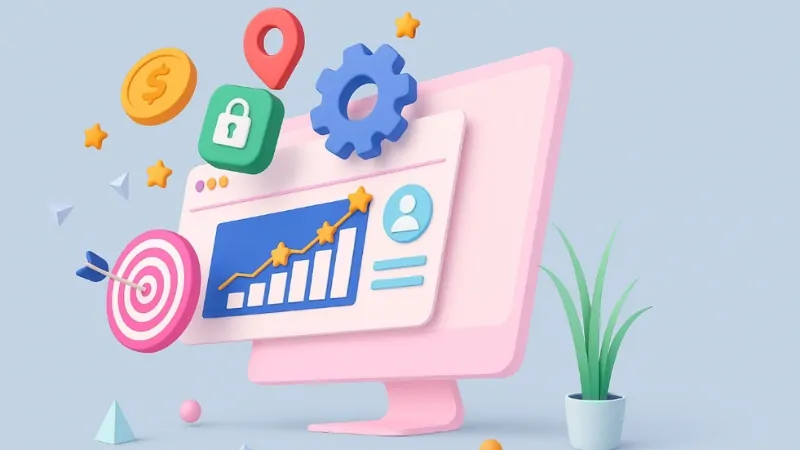Your website is the face of your brand, the first impression for potential clients, and often the central hub for all your marketing efforts.
That’s why crafting a strategic website content plan is essential, one that not only reflects your brand’s identity but also clearly communicates your value and services.
Think of your website as a living library of your brand. It should deliver a seamless user experience, showcase visually engaging design, and offer media-rich content that keeps visitors interested and informed.
When done right, your website becomes more than just a marketing tool, it becomes a long-term asset in the evolving landscape of digital marketing.
1. Define What Sets You Apart
Before you get into structuring your website or building out content silos, it’s crucial to start with a clear understanding of your Unique Selling Proposition (USP).
This is the core value that differentiates your business from the competition — and it should guide everything you include on your website.
Your USP is the promise or benefit that only you can offer, and it’s what makes your brand memorable.
To give you a clearer idea, here are a few standout examples of brands that have nailed their USPs:
Each of these statements is short, specific, and instantly communicates what the brand stands for.
A strong USP not only sets the tone for your website content but also shapes your overall messaging strategy, making your brand more compelling to potential customers.
2. Evaluate What You Have
Once your USP is clearly defined, the next step is to take stock of your existing website content and structure.
This involves performing a thorough evaluation of all your digital assets, essentially, a content audit.
Start by creating an inventory of the key pages your website should include:
- Homepage
- About Us
- Products/Services
- FAQ
- Contact Us
- Blog
- Hidden pages, like landing pages for special offers, lead magnets, or even your 404 error page
Alongside this content review, it’s also essential to assess your site’s performance. Take a look at your analytics, track traffic, bounce rates, user behavior, and conversion paths.
View this post on Instagram
If you haven’t already set up Google Analytics, now’s the time. It’s a free, powerful tool that provides insight into how users are interacting with your site and what areas may need improvement.
Understanding what you currently have (and how it’s performing) will give you a solid foundation to refine, reorganize, or rebuild your content in a way that supports your goals.
3. Set Clear Goals and KPIs
With your content inventory complete and your USP firmly in place, the next step is to establish clear goals for your website.
These goals will act as your roadmap, helping you measure progress and make informed decisions.
To define your KPIs (Key Performance Indicators), consider asking yourself the following questions:
Are you looking to increase conversions, generate leads, boost brand awareness, or drive more traffic?
Is this part of a rebrand, a performance boost, or a strategy shift?
Understanding your ideal user helps shape messaging and design.
Are you creating awareness, encouraging consideration, or driving decisions?
Setting a timeline helps keep your project on track and focused.
Regular evaluations help you course-correct as needed.
Whether it’s conversion rates, time on page, bounce rate, or engagement, make sure your metrics are clear and measurable.
By answering these questions, you can turn abstract goals into actionable steps — and ensure your website content is always aligned with your business strategy.
4. Map Out Your Website Structure

Think of this as building the blueprint before construction begins. You can use a notetaking app, flowchart tool, or even simple pen and paper to sketch out your website’s content layout.
This process not only helps define your content silos (the major categories and supporting pages) but also allows you to start visualizing how your site will look and function.
During this stage, it’s also a great time to begin exploring design inspiration and best practices that align with your brand identity.
As you lay out your content, remember that content pruning is an ongoing task — regularly review and remove outdated or irrelevant material to keep your website fresh and focused.
And don’t forget to prioritize mobile optimization — it’s no longer optional. With Google favoring mobile-first indexing, ensuring your site is fully responsive across devices is essential for visibility and user experience.
5. Build a Keyword Strategy
@juliabroome Replying to @Cortney Glenn 🦋 you should be using these in EVERY video 📢 & I included a tutorial on how to find keywords but lmk if you have any questions!! #seo #seostrategy ♬ original sound – julez | social media
With your website’s architecture in place, it’s time to shift focus toward keywords, the foundation of your SEO strategy.
Identify the terms and phrases you want to rank for on search engines.
Each page should be optimized with a group of related keywords rather than relying on a single target keyword. This helps build context and supports a more natural flow of content.
However, it’s important to be strategic.
Avoid repeating keywords excessively, as this can lead to penalties for keyword stuffing.
Instead, aim for a balanced, thoughtful use of keywords that supports both search engine optimization and a positive reading experience for your visitors.
You can streamline this process and generate optimized content efficiently by using an AI SEO writer, which helps integrate keywords naturally while maintaining high-quality writing.
6. Create Valuable, Engaging Content
In the world of SEO, one thing remains true: quality content is king. Once you’ve outlined your content plan and selected your target keywords, it’s time to start creating.
Begin by thinking about what your audience truly wants to learn. Address their questions, solve their problems, and offer insights they’ll find useful.
But remember — it’s not just about delivering large blocks of information. Your content should be easy to read, visually appealing, and enriched with relevant media.
Craft your content with a conversational tone, tell stories where appropriate, and stay informative. Above all, avoid keyword stuffing or spammy writing.
Every page should offer genuine value — that’s what keeps users engaged and helps your site rank well in search engines.
One thing you should never underestimate is the power of social media like Facebook, Instagram, and others. With that in mind, if you can find a tool to create a Facebook post for free, or for any other social media platform, for that matter, you should definitely do it.
7. Enhance Your Content with Visuals

Adding high-quality images isn’t just about making your site look good; it improves user experience, increases engagement, and can even support your SEO when done correctly.
However, for many small and medium-sized businesses, sourcing top-tier, relevant imagery can be a challenge.
Bottom Line
Your website isn’t just a digital brochure — it’s your brand’s most powerful marketing asset. A strong, strategic content plan not only tells your story but drives real business results.
By defining your unique value, auditing existing content, setting clear goals, building a thoughtful site structure, optimizing for SEO, and enriching everything with compelling visuals, you lay the foundation for a site that attracts, converts, and grows with your business.
Ready to take your website from average to unforgettable? Start with strategy, and let your content do the heavy lifting.

